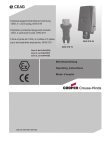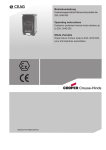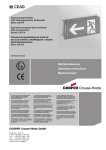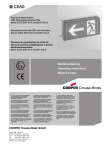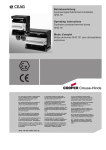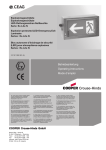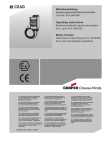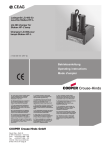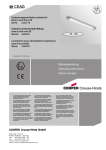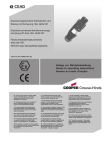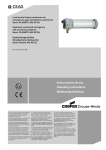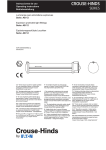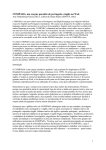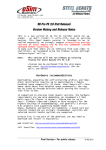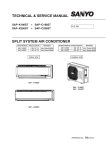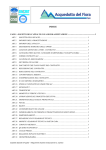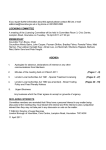Download AB12 NAV70_Rev_d.p65 - CROUSE
Transcript
Luminarias para atmósferas explosivas Series: AB 12 NAV 70 Explosion protected light fitttings Series: AB 12 NAV 70 Explosionsgeschützte Leuchten Serie: AB 12 NAV 70 NOR 000000506985 (d) 09-07-2012 Instrucciones de uso Operating instructions Betriebsanleitung &=7HQWRQiYRGNSRXåLWtVLPåHWHY\åiGDW YHVYpPPDWHĜVNpPMD]\FHXSĜtVOXãQpKR ]DVWRXSHQtVSROHþQRVWL&RRSHU&URXVH +LQGV&($*YHYDãt]HPL +$NH]HOpVL~WPXWDWyWD]DGRWWRUV]iJ Q\HOYpQD&RRSHU&URXVH+LQGV&($*FpJ KHO\LNpSYLVHOHWpQLJpQ\HOKHWLPHJ '.0RQWDJHYHMOHGQLQJHQNDQRYHUV WWHVWLO DQGUH(8VSURJRJUHNYLUHUHVKRV'HUHV &RRSHU&URXVH+LQGV&($*OHYHUDQG¡U ,6HGHVLGHUDWHODWUDGX]LRQHGHOPDQXDOH RSHUDWLYRLQXQDOWUDOLQJXDGHOOD&RPXQLWj (XURSHDSRWHWHULFKLHGHUODDOYRVWUR UDSSUHVHQWDQWH&RRSHU&URXVH+LQGV&($* ((QFDVRQHFHVDULRSRGUiVROLFLWDUGHVX UHSUHVHQWDQWH&RRSHU&URXVH+LQGV&($* HVWDVLQVWUXFFLRQHVGHVHUYLFLRHQRWURLGLRPD GHOD8QLRQ(XURSHD /7âLRVQDXGRMLPRLQVWUXNFLMRVLãYHUVWRVƳ-njVǐ JLPWąMąNDOEąJDOLWHSDUHLNDODXWLDWVDNLQJRMH &RRSHU&URXVH+LQGV&($*DWVWRY\EHMHVDYR ãDO\MH (676HGDNDVXWXVMXKHQGLWRPDULLJLNHHOHV Y}LWHNVLGDRPDULLJLVDVXYDVWDVMDRPDVHVW &RRSHU&URXVH+LQGVL&($*HVLQGXVHVW /9âRHNVSOXDWƗFLMDVLQVWUXNFLMXYDOVWVYDORGƗ YDUDWSLHSUDVƯWMXVXYDOVWVDWELOGƯJDMƗ&RRSHU &URXVH+LQGV&($*SƗUVWƗYQLHFƯEƗ ),17DUYLWWDHVVDWlPlQNl\WW|RKMHHQNllQQ|V RQVDDWDYLVVDWRLVHOOD(8QNLHOHOOl7HLGlQ &RRSHU&URXVH+LQGV&($*HGXVWDMDOWDQQH 0-LVWJƫXMLWROEXGDQLOPDQZDOILOOLQJZD QD]]MRQDOLWDJƫKRPPLQJƫDQGLUUDSSUHĪHQWDQW WD &RRSHU&URXVH+LQGV&($*I SDMMLĪKRP *5ǼĮȞȤȡİȚĮıșİȚİIJĮȡĮıȘIJȦȞȠįȘȖȚȦȞȤȡȘıİ ȦȢıİĮȜȜȘȖȜȦııĮIJȘȢǼǼʌȠȡİȚȞĮȗȘIJȘșİȚĮʌȠ IJȠȞǹȞIJȚʌȡȠıȦʌȠIJȘȢ&RRSHU&URXVH +LQGV&($*³ 1/,QGLHQQRRG]DNHOLMNNDQGHYHUWDOLQJYDQ GH]HJHEUXLNVLQVWUXFWLHLQHHQDQGHUH(8WDDO ZRUGHQRSJHYUDDJGELM8Z&RRSHU&URXVH +LQGV&($*YHUWHJHQZRRUGLJLQJ 36HIRUQHFHVViULDDWUDGXomRGHVWDV LQVWUXo}HVGHRSHUDomRSDUDRXWURLGLRPDGD 8QLmR(XURSHLDSRGHVROLFLWDODMXQWRGRVHX UHSUHVHQWDQWH&RRSHU&URXVH+LQGV&($* 3/1LQLHMV]ąLQVWUXNFMrREVáXJLZRGSRZLHGQLHM ZHUVMLMĊ]\NRZHMPRĪQD]DPyZLüZ SU]HGVWDZLFLHOVWZLHILUP\&RRSHU&URXVH +LQGV&($*QDGDQ\NUDM 6(Q|YHUVlWWQLQJDYGHQQDPRQWDJHRFK VN|WVHOLQVWUXNWLRQWLOODQQDW(8VSUnNNDQYLG EHKRYEHVWlOODVIUnQ(U&RRSHU&URXVH +LQGV&($*UHSUHVHQWDQW 6.7HQWRQiYRGQDREVOXKX9iPYR9DãRP URGQRPMD]\NXSRVN\WQH]DVW~SHQLHVSRORþQRVWL &RRSHU&URXVH+LQGV&($*YR9DãHMNUDMLQH 6/21DYRGLOD]DXSRUDERY9DãHPMH]LNX ODKNR]DKWHYDWHSULSULVWRMQHP]DVWRSQLãWYX SRGMHWMD&RRSHU&URXVH+LQGV&($*Y9DãL GUåDYL Cooper Crouse-Hinds, S.A. Av. Sta. Eulalia, 290 E-08223 Terrassa Internet: http://www.CEAG.de E-Mail: [email protected] 1 Cooper Crouse-Hinds, S.A. Fig. 1 Diagrama de conexión AB 12 NAV 70 / Wiring diagram AB 12 NAV 70 1 - Reactancia TRIDONIC OMBIS 70W 1 - Ballast TRIDONIC OMBIS 70W 2 - Condensador ELT 12µF + 10% 250V 50/60Hz 2 - Capacitor ELT 12µF + 10% 250V 50/60Hz Fig. 2 DImensiones / Dimensions 405 M8 144 140 460 Fig. 3 Tabla 1. Configuración de tipos / Types configuration Clase de temperatuera Tipo Type AB12NAV 70 Tubos Tamaño Portalámparas Temperature class Lamp Tubes HPS 70W Size 1 Lampholder E 27 hasta / up to +55ºC T3 Temperatura superficial Peso Surface temperature Weight hasta / up to +55ºC T160ºC [k] 5,30 2 Cooper Crouse-Hinds, S.A. 1. Instrucciones de seguridad La instalación y conexiones eléctricas de las luminarias deben ser realizadas por electricistas y/o personal cualificado e instruido de acuerdo con EN 60079-14 y la respectiva legislación nacional para aparatos eléctricos en atmósferas explosivas. Deben observarse las reglas nacionales de seguridad y de prevención de accidentes, así como las instrucciones de seguridad indicadas en este manual en itálica-negrita, como este texto. Estas luminarias no deben instalarse ni funcionar en emplazamientos peligrosos de Zonas 0 ó 20. Deben considerarse por el usuario los requisitos de la norma 60079-14 en relación con excesivos depósitos de polvo y temperatura. Las temperaturas superficiales indicadas no se aplican con capas de polvo de más de 5mm de espesor. No abrir con tensión y dejar transcurrir al menos 10 minutos antes de abrir la luminaria para permitir un adecuado enfriamiento. Debe tenerse en cuenta la clase térmica y el grupo de explosión que aparece en la caratula de las luminarias. Se observará la temperatura ambiente de uso para garantizar el cumplimiento de la clase térmica o la temperatura superficial indicada en la caratula de la luminaria Las luminarias se harán funcionar según lo previsto y únicamente deben utilizarse cuando no existan defectos, estén limpias y en perfectas condiciones de uso. Mantenga la envolvente debidamente cerrada cuando la luminaria este en funcionamiento. Deben observarse los datos técnicos indicados en el punto 3 como así también los indicados en la luminaria. No están permitidos los cambios en el diseño ni las modificaciones en las luminarias que puedan afectar la protección contra explosión. Evitar múltiples funcionamientos de corta duración. Para reemplazos y reparaciones deben usarse solo recambios originales COOPER Crouse-Hinds. Las reparaciones que afecten al modo de protección, sólo pueden ser realizadas por COOPER Crouse-Hinds o por personal cualificado y seguidamente revisadas por un experto de acuerdo con los respectivos reglamentos nacionales. Antes de su puesta en funcionamiento, las luminarias se comprobarán de acuerdo con las instrucciones de la sección 6. Cualquier material extraño deberá ser retirado de las luminarias antes de su puesta en funcionamiento. No guardar estas instrucciones de operación en el interior de las luminarias durante su funcionamiento. 2. Conformidad con normas Estas luminarias para atmósferas explosivas están conformes a las normas indicadas en la declaración de conformidad CE. Han sido diseñadas, fabricadas y ensayadas según el estado del arte y de la técnica actual y de acuerdo con EN ISO 9001, así como a la Directiva 94/9/CE "Aparatos y sistemas de protección para su uso en atmósferas explosivas" y 2004/108/EC "Compatibilidad electromagnética". 3. Datos técnicos Categoría de aplicación directiva ATEX 94/9/EG: Certificado de examen CE de tipo: Tensión nominal: Bornes: Grado de protección según EN/IEC 60529: Clase de aislamiento según EN/IEC 60598: Temperatura ambiente de uso: Grupo IIC Grupo IIB Temperatura de almacenamiento en embalaje original: Material: Globo: Terminación: Color (versión estándar): Dimensiones: Entradas de cable: 4. II 2 G Ex d IIC / IIB T3 II 2 D Ex tb IIIC T160°C Db LOM 02ATEX2013X 220-240V, 50/60Hz 176-275V CC 2x2,5mm2 L y N, 6mm2 PE ext. IP 67 I -20ºC a + 55ºC -50ºC a + 55ºC -40ºC to + 60ºC Aleación de aluminio exento de Cu Vidrio Borosilicato Pintura epoxi RAL 7032, tapa RAL 7016 Véase Fig. 2 2x3/4"NPT ó 2xM25x1,5 ó 2xM20x1,5, una taponada Ámbito de aplicación Estas Luminarias, están diseñadas para su uso en atmósferas potencialmente explosivas, Zonas 1 y 2 según EN/IEC 60079-10-1 y en zonas 21 y 22 según EN/IEC 60079-10-2. Los materiales de la envolvente utilizada, incluidas las partes metálicas externas, son materiales de alta calidad que garantizan la resistencia a la corrosión y resistencia a las sustancias químicas de acuerdo a los requisitos para uso en un ambiente industrial "normal". - Aluminio exento de cobre. - Acero inoxidable. - Acabado con pintura epoxi en polvo. - Vidrio borosilicato En caso de uso en un ambiente muy agresivo, por favor, consulte previamente con el fabricante. 5. Uso / Propiedades Las luminarias pueden ser usadas en interior o exterior para iluminar áreas peligrosas por atmósferas potencialmente explosivas de gas o polvo, se pueden utilizar sólo en lugares con bajo riesgo de impacto mecánico, debido a la operación normal en el proceso industrial. La clase térmica, el grupo de explosión y la temperatura ambiente de uso pueden encontrase en las tablas y datos técnicos. Se deberán tener en cuenta los datos indicados en las secciones 2 y 4 durante el uso. No está permitida ninguna aplicación o uso fuera de la aquí descripta sin una declaración de consentimiento escrita por parte de COOPER Crouse-Hinds. Se observarán las instrucciones estipuladas en la sección 7 de estas instrucciones de uso durante la operación. El operador/usuario debe determinar bajo su única responsabilidad la idoneidad del equipo para su uso previsto y asume todos los riesgos y responsabilidades en relación con ello. 3 Cooper Crouse-Hinds, S.A. 6. Instalación La instalación y operación deben ser realizadas de acuerdo con EN/IEC 60079-14, la normativa nacional pertinente y las normas generalmente reconocidas de la ingeniería. El transporte y almacenamiento de estas luminarias sólo está permitido en su embalaje original y en las posiciones especificadas. Tener especial cuidado cuando se instalan, mantienen o reparan las luminarias de no dañar la piel exterior del vidrio, ya sea por pequeños golpes, abrasión, arenado, etc. ya que esto puede debilitar sus propiedades mecánicas. La radiación solar directa e intensa en áreas de alta temperatura ambiente puede producir una temperatura inadmisiblemente elevada en el interior de las luminarias. Esto puede resultar en una reducción drástica de la vida útil de los componentes electrónicos interiores. Por lo tanto las luminarias deben estar apagadas durante el día por un control de la fotocélula por ejemplo. Protección contra defectos a tierra, la corriente de defecto a tierra de las luminarias AB12 es normalmente inferior a 1 mA, por esta razón se recomienda no instalar más de 30 luminarias por cada interruptor diferencial con sensibilidad de 30mA. Una instalación u operación inadecuada de las luminarias pueden dar lugar a la invalidación de la garantía. 6.1 Montaje Las distancias de fijación se muestran en la figura 2 (B). Estas luminarias son aptas para montaje techo, mural o en báculo, los accesorios de montaje no se incluyen en el suministro, véase el catálogo COOPER Crouse-Hinds para una correcta selección de los accesorios de montaje. Las instrucciones de uso para los diferentes accesorios de montaje se suministran con estos. Véase los planos y/o instrucciones de montaje específicas para cada accesorio de montaje. Las luminarias deberán fijarse de manera uniforme, planas, libres de torsión y sólo en los puntos de fijación previstos para ello. Los tornillos, no incluidos en el suministro, que se elijan deberán ajustarse al orificio de fijación y no dañar el mismo (por ejemplo mediante el uso de una arandela plana). El número de tornillos utilizados para fijar las luminarias se corresponderá con el número de agujeros de fijación. Se prestará especial atención a las conexiones de puesta a tierra. Advertencia: Si se aprieta demasiado puede dañar la luminaria. 6.2.1 Lámparas Los tubos apropiados para cada tipo de luminaria están especificados en la tabla 1 como así también en la carátula de las luminarias. Para la instalación de los tubos, una vez realizados los pasos del punto 6.2 (véase Fig. 3), quite las dos tuercas (4) y extraiga la bandeja (5). Tener especial cuidado al retirar el cable para la conexión a tierra interna entre la bandeja y el cuerpo de la luminaria. Instale o reemplace los tubos apropiados en los respectivos portalámparas, controle que estén instalados con seguridad, inserte nuevamente la bandeja, véase Fig. 3 (5), conecte el cable para la conexión a tierra interna entre la bandeja y el cuerpo de la luminaria, enrosque las dos tuercas (4), y luego cierre la luminaria tal y como se indica en el punto 6.4. Sólo pueden utilizarse los tubos aprobados para cada tipo de luminaria, si se tiene cualquier duda acerca de los tubos a utilizar, por favor consulte con COOPER Crouse-Hinds. 6.3 Entradas de cable Ex-d / Tapones Ex-d Sólo pueden usarse entradas de cable y tapones debidamente certificados Ex-d. Estos deben ser aptos para el mismo grupo de explosión que las envolventes, en este caso, grupo IIC para gases y grupo IIIC para polvo. Deben observarse las directrices pertinentes de montaje e instalación del fabricante para las entradas de cables y los tapones antideflagrantes Ex-d certificados. Al utilizar las entradas de cables con un grado de protección IP inferior al grado de protección IP de las envolventes de los equipos (véase el punto 3, datos técnicos), el grado de protección IP para la unidad completa se reduce. Con el fin de asegurar el grado de protección IP mínimo requerido, las entradas de cable deberán estar correctamente apretadas. Par de apriete, 15Nm para el caso de los tapones originales suministrados con la luminaria. Un apriete excesivo puede deteriorar el grado de protección. Con el fin de garantizar y/o establecer la protección contra explosiones y el grado de protección, las entradas no utilizadas se obturarán con tapones debidamente certificados Ex-d. 6.2 Apertura de la luminaria / Conexión eléctrica Antes de abrir la luminaria, es necesario asegurarse de que no hay tensión y que se han dejado enfriar por al menos 10 minutos después de la desconexión. La conexión de las luminarias sólo puede llevarse a cabo por los especialistas. Las luminarias deben conectarse directamente dentro de las envolventes antideflagrante utilizando para ello entradas de cables debidamente certificadas en modo de protección antideflagrante Ex-d, por lo que se tomarán en cuenta las instrucciones de montaje indicadas para dichas la entradas del cable (véase la sección 6.3 entradas de cables). Advertencia: A fin de mantener el modo de protección Ex-d, es esencial prestar atención al correcto montaje del cable y de las entradas de cables. Para abrir la envolvente antideflagrante (véase la Fig. 3), se tiene que desenroscar el tornillo de enclavamiento (1) en la tapa, ahora se puede quitar la tapa (2) girando la misma en sentido anti-horario. Advertencia: Si bien la tapa posee un mecanismo de seguridad, deberá protegerse esta contra una caída o golpes. Para mantener la protección contra explosiones, los conductores se conectarán con especial cuidado. El aislamiento del cable debe llegar hasta el borne de conexión. El cable en si mismo no estará dañado. Se deberá respetar las secciones de cable máximas y mínimas que se especifican en el punto 3 para los bornes de conexión. Todos los tornillos y las tuercas de los terminales o bornes de conexión, incluidos los que no estén en uso, deberán apretarse correctamente y de forma segura. Un apriete excesivo puede afectar a la conexión. 4 Cooper Crouse-Hinds, S.A. 6.4 Cierre de los equipos / bloqueo de la tapa Retire cualquier elemento extraño del equipo. Engrase la rosca de la tapa antes de colocar la tapa, de preferencia con grasa térmica y químicamente estable, por ejemplo: MOLIKOTE® BR2 plus. Preste atención al correcto alojamiento de las juntas de estanqueidad en la tapa, Las juntas han de estar limpias y no presentaran daño alguno. Para cerrar la luminaria, véase Fig. 3 (2), es necesario colocar la tapa en la base correctamente (si es necesario, gire la tapa en sentido antihorario). La cubierta puede ahora enroscarse a la base girándola en sentido horario hasta que se alcance el tope. Después de esto, la cubierta se fijará en la posición con el tornillo de enclavamiento de la tapa, véase Fig. 1 (3). 6.5 Puesta en marcha Antes de poner en funcionamiento las luminarias, se llevarán a cabo los ensayos especificados en las respectivas normas nacionales. Además de esto, antes de su puesta en marcha, se verificará de acuerdo con estas instrucciones de funcionamiento y demás normativa aplicable el correcto funcionamiento de las luminarias. Sólo se llevarán a cabo medidas de aislamiento entre PE y los conductores externos L1 (L2, L3), así como entre PE y N. - Tensión de ensayo: Max. 1KV CA/CC - Corriente de ensayo: Máx. 10 mA La luminaria sólo puede utilizarse cuando está debidamente cerrada. Advertencia: Sólo pueden ser puestos en funcionamiento los equipos certificados. La instalación y/u operación inapropiada de las luminarias conlleva la pérdida de su garantía. 7. Las piezas dañadas se sustituirán inmediatamente por piezas de recambio originales o serán reparadas por el fabricante. Compruebe que las conexiones, las entradas de cables y tapones ciegos estén apretados debidamente y de forma segura. Todo el material eléctrico y electrónico en el interior de las envolventes se mantendrá de acuerdo a sus propias instrucciones. Si, durante las operaciones de mantenimiento, se comprueba que es necesario efectuar reparaciones, deberá observarse la sección 8 de estas instrucciones de uso. 8. Reparación / Reacondicionamiento / Modificaciones Las reparaciones y reacondicionamientos sólo pueden llevarse a cabo con piezas de recambios genuinas COOPER Crouse-Hinds. Aísle y quite tensión antes de abrir cualquier envolvente y comenzar el desmantelamiento de cualquier pieza individual. Utilice sólo piezas de repuesto originales. Las reparaciones que afecten al modo de protección contra explosiones sólo pueden llevarse a cabo por COOPER Crouse-Hinds o por un electricista cualificado de acuerdo con la respectiva reglamentación nacional. Para las reparaciones de equipos con modo de protección es aconsejable seguir las pautas establecidas en la norma EN/IEC 60079-19. No están permitidas las modificaciones en el dispositivo ni cambios en su diseño. ¡Todas las reparaciones se harán sin tensión! En caso de daño en las envolventes antideflagrantes u otra parte de los equipos que pudiera afectar al modo de protección, es obligatoria la sustitución de dichas partes. En caso de duda, los respectivos equipos se enviarán a COOPER CrouseHinds para su reparación. Sólo es posible la reconstrucción o modificación de los equipos dentro del alcance de las homologaciones y serán certificadas después. Mantenimiento / Servicio Deben observarse las regulaciones nacionales pertinentes que se aplican para el mantenimiento / servicio de aparatos eléctricos en atmósferas explosivas, por ejemplo EN/IEC 60079-17. Antes de abrir las envolventes, es necesario asegurarse que la tensión de alimentación de los equipos haya sido debidamente desconectada y que se ha dejado transcurrir el tiempo entre desconexión y apertura especificado en las envolventes. El intervalo necesario entre mantenimientos depende de la aplicación específica y será estipulado por el usuario de acuerdo a las respectivas condiciones de operación. Se recomienda un mantenimiento regular de acuerdo a un programa aprobado de mantenimiento preventivo. Como parte de las rutinas de pruebas los dispositivos de disparo por protección diferencial deben ser probados dos veces al año. En servicio, sobre todo, las partes que afectan a la protección contra explosiones, tendrán que inspeccionarse visualmente y controlarse con la finalidad de asegurar su correcto estado, por ejemplo: - Las envolventes y sus partes roscadas estarán debidamente engrasadas, en buenas condiciones, limpias no presentaran grietas, daños ni corrosión. - Las juntas roscadas no pueden ser tratadas, pintadas ni barnizadas, sólo estarán engrasadas. - Las conexiones y los tapones obturadores deben estar debidamente apretados. - Comprobar la eficiencia e integridad de todas las juntas de estanqueidad. Reemplace las juntas antiguas o dañadas por juntas nuevas. ADVERTENCIA Para evitar el riesgo de incendio, explosión o descarga eléctrica, este producto debe ser instalado, inspeccionado y mantenido por un electricista cualificado, de acuerdo con los reglamentos eléctricos aplicables. 9. Eliminación / reciclaje Cuando el equipo o cualquiera de sus partes se elimina, deberán observarse los respectivos reglamentos nacionales en materia de eliminación de residuos. Con el fin de facilitar el reciclaje de los distintos componentes, las piezas de plástico incluyen una marca de identificación del material plástico utilizado. . Todas las declaraciones, información técnica y recomendaciones contenidas en este documento están basadas en la información y las pruebas que consideramos fiables. La exactitud o la exhaustividad de los mismos no están garantizados. De acuerdo con los "Términos y Condiciones de Venta" de COOPER Crouse-Hinds, y dado que las condiciones de uso están fuera de nuestro control, el comprador debe determinar la idoneidad del producto para su uso previsto y asume todos los riesgos y responsabilidades en relación con ello. Sujeto a cambios y/o suplementos de esta serie sin previo aviso. Guarde estas instrucciones para futuras referencias 5 Cooper Crouse-Hinds, S.A. 1. Safety Instructions This product should be Installed and connected by skilled electricians and instructed personnel in accordance with 60079-14 and the respective national legislation on electrical equipment for explosive atmospheres. The national safety rules and regulations for the prevention of accidents, as well as the safety instructions, like this text set in bold-italics in these operating instructions manual, shall be observed! The luminaries must not be operated in Zone 0 or 20 hazardous areas. The requirements of 60079-14 regarding excessive dust deposits and temperature must be considered by the user. The indicated surface temperatures are not related to a layer above 5mm thickness Before opening, electrical power to the luminaire must be turn off during at least 10minutes! The temperature class and explosion group stated on the luminaire shall be observed. To ensure adherence to the temperature class or surface temperature stated on the type label of the luminaire, the permissible ambient temperature shall be observed. Light fitting shall be used for their intended purpose and shall be undamaged and in a perfect and clean conditions. Keep tightly closed when in operation. The technical data indicated in point 3 as well as those indicated in light fitting, must be observed. Modifications or design changes to this luminaries that can affect the explosion protection are not permitted. Avoid multiple, short time switching operation Only original COOPER Crouse-Hinds spare parts may be used as replacements and for repairs. Repairs that affect the explosion protection may only be carried out by COOPER Crouse-Hinds or by a qualified electrician in compliance with the respective national regulations. Prior to being put into operation, the luminaries shall be checked in accordance with the instructions as per section 6. Before initial operation, any foreign matter shall be removed from light fitting, do not keep this operating instructions manual inside of the luminaire during its operation. 2. Conformity with standards This light fitting is conform to the standards specified in the EC-Declaration of conformity. It has been designed, manufactured and tested according to the state of the art and to DIN EN ISO 9001, 94/9 EC: Equipment and protective systems intended for use in potentially explosive atmospheres. The light fitting fulfill further requirements, such as the EC directive on electromagnetic compatibility (2004/108/EC). 3. Technical data Apparatus marking acc. to 94/9/EG and directive: EC-type examination certificate: Rated voltage: Rated current: Power consumption: Luminous flux ΦE/ΦN at the end of rated operating time: Terminals: Degree of protection EN/IEC 60529: Insulation class EN/IEC 60598: Perm. ambient temperature: Group IIC Group IIB Storage temperature in original packaging: Enclosure material: Glass material: Enclosure surface finish: Color of enclosure (standard version): Dimensions: Cable entries: 4. II 2 G Ex d IIC / IIB T3 Gb II 2 D Ex tb IIIC T160°C Db LOM 02ATEX2013X 220-240V, 50/60Hz 176-275 VDC 30mA 16VA 75% 2x2,5mm2 L y N, 6mm2 PE ext. IP 67 I -20ºC to +55ºC -50ºC to +55ºC -40ºC to +60ºC Aluminium alloy casting (Cu free) Borosilicate glass Plastic powder coating RAL 7032, cover RAL 7016 See Fig. 2 2x3/4"NPT or 2xM25x1,5 or 2xM20x1,5, one with blanking plug Field of application This light fitting is intended for use in potentially explosive atmospheres in zones 1, 2 and 21, 22 in accordance with EN/IEC 60079-10. The enclosure materials used, including any external metal parts, are high quality materials that ensure a corrosion resistance and resistance to chemical substances according to the requirements for use in a ”normal industrial atmosphere”: - Copper free aluminium alloy casting - Plastic powder coating finish - Stainless steel - Borosilicate glass In case of use in an extremely aggressive atmosphere, please consult to the manufacturer. 5. Use/Properties This light fitting can be use inside or outside to illuminate areas with potentially explosive atmospheres, may be used only in places with low mechanical impact risk, due to the normal operation in the industrial process. The temperature class, explosion group and permissible ambient temperature can be found in the tables and technical data. The data according to sections 2 and 4 shall be taken into account during use. Applications other than those described are not permissible without a written declaration of consent from COOPER Crouse-Hinds. During operation the instructions stated in section 7 of the operating instructions shall be observed. The sole responsibility with respect to the suitability and proper use of these luminaries lies with the operator. 6 Cooper Crouse-Hinds, S.A. 6. Installation The EN 60079-14, relevant national regulations and the generally recognized rules of engineering shall be applied for the installation and operation. Transport and storage of the luminaries is permitted in the original packaging and specified positions only. Pay attention when installing, maintaining or repairing the light fittings, do not damage the fire-finish of the glass surface by abrasions, sanding, small strokes, etc. that can weaken their mechanical functions. Intensive sun radiation in areas of high ambient temperatures may cause inadmissible temperature rise inside of the luminaries. This may result a decrease in lifetime of the electronic ballast (EVG) or electronic components inside of the luminaries. Therefore those luminaries should be switched off during daytime by a photocell control. Earth leakage protection, the earth leakage current of the luminaries AB12 is normally less than 1 mA, due to this it is suggested non install more than 30 luminaries for earth leakage switch with sensibility of 30mA. The improper installation and operation of light fittings can result in the invalidation of the guarantee. 6.1 Mounting Fixing dimensions are shown in Figure 2 (B). Luminaries are suitable for ceiling, wall or pole mounting, the accessories are not included, see COOPER Crouse-Hinds catalogue for the correct selection of the mounting accessories. The light fitting may only lie flat on and be fixed torsion-free to the fastening points provided for direct assembly. The screws chosen shall fit the fixing hole and shall not damage the hole (e.g. use of a washer, select the correct length, etc.). The number of screws used for fixing the equipment shall correspond to the number of fixing holes in the light fitting. Special attention shall be paid to the PE connections. Warning: Over tightening might damage the light fitting. 6.2 Opening the device / Electrical connection Before opening the light fitting, it is necessary to ensure that there is no voltage and it must be allowed to cool down for 10 minutes after switching off. The connection of explosion-protected light fittings may only be carried out by specialists. These luminaries shall be connected directly in the flameproof enclosure using certified flameproof cable entries, whereby the mounting instructions for the cable entry shall be taken into account (see Section 6.3 Cable Entries). Warning: In order to establish the type of protection "Ex-d flameproof ", it is essential to pay attention to the correct mounting of the cable and cable entry. To open a flameproof enclosure (see Fig. 3), the interlocking screw, item 1, in the cover has to be unscrewed. The cover, item 2, can then be removed from the luminary by turning it anticlockwise. Warning: The cover shall be safeguarded against falling off. To maintain the explosion protection, conductors shall be connected with special care. The insulation shall reach up to the terminal. The conductor itself shall not be damaged. The minimum and maximum conductor cross sections that can be connected shall be observed, see point 3 technical data. All screws and/or nuts of connection terminals, including those not in uses, shall be tightened down securely. Excessive tightening can affect the connection. 6.2.1 Lamp The lamp tube type approved for each light fitting is specified in table 1 and in the label of the luminaries. For installation of lamps tubes, once performed the steps mentioned in point 6.2 (see Fig 3), remove the 2 nuts item 4 and extract the tray, item 5. Take special care to remove correctly the cable for internal PE connection between tray and body of the light fitting. Install or replace the suitable lamps into the corresponding lamp holders, test for a secure installation, insert the tray again, see Fig. 3 item 5, connect the cable for internal PE connection between tray and body of the light fitting, screw the 2 nuts, item 4, and then close the light fitting as indicated in point 6.4. Only lamps tubes that are approved for each type of light fitting may be used. If you have any doubt, please consult with COOPER CrouseHinds. 6.3 Ex-d cable entries / Ex-d blanking plugs Only suitable certified flameproof cable entries and certified flameproof blanking plugs may be used. These should be for the same groups of explosion of the light fittings, in this case IIC for gas and IIIC for dust. The relevant mounting and installing manufacturer directives for certified cables entries and blanking plugs shall be observed. When using cable entries with a degree of protection that is lower than the IP protection of the light fitting (see Technical Data), the degree of protection IP for the complete unit is reduced. In order to ensure the required minimum degree of protection, the cable entries shall be tightened down securely. Torque of 15Nm for the original plug suppied with the light fitting. Over tightening can impair the degree of protection. In order to guarantee and/or establish the explosion protection and degree of protection, unused entry holes shall be sealed with a certified flameproof blanking plug. 6.4 Closing equipments / Cover lock Any foreign matter shall be removed from the equipment. Grease the cover thread before screwing the cover, preferably with grease thermally and chemically stable i.e.: Molikote® BR2 plus. Pay attention to the correct fit of the seal into the cover. All seals must be clean an undamaged To close the light fitting, see fig. 3 item 2, it is necessary to fit the cover onto the light fitting body correctly (if necessary, turn the cover anticlockwise). The cover can then be screwed into the enclosure base by turning it in a clockwise direction until the stop is reached. After this, the cover shall be fixed in position with the interlocking screw of the cover, see Fig. 3 item 1. 6.5 Putting into operation Before putting the light fitting into operation, the tests specified in the individual national regulations shall be performed. In addition to this, the correct functioning of the light fitting shall be checked in accordance with these operating instructions and other applicable regulations. Only carry out insulation measurement between PE and external conductor L1 (L2, L3) as well as between PE and N. - Measurement voltage:Max. 1KV AC/DC - Measurement current:Max. 10 mA The light fitting may only be operated when closed Warning: Only certified equipments may be put into operation. Improper installation and operation of the lamp leads to loose of the guarantee 7 Cooper Crouse-Hinds, S.A. 7 Maintenance / Servicing The valid national regulations for the maintenance/servicing of electrical equipments for use in potentially explosive atmospheres shall be observed (i.e. EN/IEC 60079-17). Before opening the enclosure, it is necessary to ensure that the voltage supply has been isolated and should allowed to cool down for 10 minutes after switching off. The necessary intervals between servicing depend upon the specific application and shall be stipulated by the operator according to the respective operating conditions. We recommend a regular maintenance according to an approved preventive maintenance program. During servicing, above all, parts on which the explosion protection depends shall be tested or visually inspected to ensure their correct state, i.e.: - Enclosure threaded parts like cover and cable entries, shall be properly greased, in good conditions, clean and without any corrosion or damaged. - The thread shall not be treated, painted nor varnished!, preferably with grease thermally and chemically stable i.e.: Molikote® BR2 plus. - Check all seals for efficiency and intactness.Replace older or damaged seals with new seals. - Be aware about the lamp tube change intervals specified by the manufacturer of it, lamp tubes types must be as specified. Any damaged parts shall be replaced immediately using original parts or damaged parts shall be repaired by the manufacturer. Check that connection terminals, cable entries and blind plugs fit securely. All electrical and electronic material inside of the enclosure shall be maintained as per their own instructions. If, in the course of servicing, it is ascertained, that repairs are necessary, section 8 of these operating instructions shall be observed. 8 Repair / Overhaul / Modifications Repairs and overhaul may only be carried out with genuine COOPER Crouse-Hinds spare parts. Switch off the equipment before opening or isolate it before the dismantling of individual parts. Only use original spare parts. Repairs that affect the explosion protection may only be carried out by COOPER Crouse-Hinds or a qualified electrician in compliance with the applicable national rules. For repair electrical equipments in protection mode is suggested follow the instructions indicated in EN/IEC 60079-19. Modifications to the equipments or changes of its design are not permitted. All reparations have to be done without voltage! In the event of damage to the flameproof enclosures or other part of equipments that could affect the mode of protection, replacement of these components is mandatory. In case of doubt, the respective equipments shall be sent to COOPER CrouseHinds for repair. Reconstruction or modifications to equipments are only possible within the scope of the approvals and shall be certified afterwards. 9 Disposal / Recycling When the equipment or their parts is disposed of, the respective valid national regulations on waste disposal shall be observed. In order to facilitate the recycling of individual components, plastic parts are provided with the identification mark of the plastic material used. Warning To avoid the risk of fire, explosion, or electric shock, this product should be installed, inspected, and maintained by a qualified electrician only, in accordance with all applicable electrical codes. All statements, technical information and recommendations contained herein are based on information and tests we believe to be reliable. The accuracy or completeness thereof are not guaranteed. In accordance with Crouse-Hinds "Terms and Conditions of Sale" and since conditions of use are outside our control, the purchaser should determine the suitability of the product for his intended use and assumes all risk and liability whatsoever in connection therewith. Subject to alteration or supplement of this product without any advertisement before. Save these instructions for future reference. 8 Cooper Crouse-Hinds, S.A. CE – Declaración de conformidad EG – Konformitätserklärung EC – Declaration of conformity CE – Déclaration de conformité LOM 02 ATEX 2013X Nosotros / wir / we / nous Cooper Crouse-Hinds, S.A. Av. Sta. Eulalia, 290 E-08223 Terrassa declaramos bajo nuestra única responsabilidad, que las erklären in alleiniger Verantwortung, dass die hereby declare in our sole responsibility, that the déclarons de notre seule responsabilité, que le Luminarias fluorescentes Leuchte mit Leuchtstofflampen Luminairewith fluorescent lamps Luminaire avec fluorescentes pour II 2 G - Ex d IIB / IIC T3 Gb II 2 D - Ex tb IIIC T160ºC Db IP67 AB12 NAV 70 objeto de la presente declaración es conforme a las siguientes normas o documentos normativos. auf die sich diese Erklärung bezieht, mit den folgenden Normen oder normativen Dokumenten übereinstimmen. which are the subject of this declaration, are in conformity with the following standards or normative documents. auquel cette déclaration se rapporte, est conforme aux normes ou aux documents normatifs suivants. Prescripción de la directiva Bestimmungen der Richtlinie Terms of the directive Prescription de la directive Título y/o Nr. así como fecha de emisión de las normas Titel und / oder Nr. sowie Ausgabedatum del Norm. Title and / or No. and date of issue of the standards Titre et / ou No. ainsi que date d’émission des normes. 94/9/CE: EN 60 079-0: 2009 EN 60 079-1: 2007 EN 61 241-0: 2009 EN 60 598-1: 2008 + A11: 2009 EN 60 598-2-1: 1989 Aparatos y sistemas de protección para su utilización en atmósferas explosivas Geräte und Schutzsysteme zur bestimmungsgenäβen Verwendung in explosionsgefährdeten Bereichen Equipment and protective systems intended for use in potentially explosive atmospheres. Appareils et systèmes de protection destinés à ètre utilisés en atmosphère explosibles. 94/9/EG: 94/9/EC: 94/9/CE: 2004/108 2004/108 2004/108 2004/108 CE: EG: EC: CE: Compatibilidad electromágnetica Elektromagnetische Vertráglichkeit Electromagnetic compatibility Compatibilitè électromagnètique EN 55 015: 2006 + A1: 2007 EN 61 347-2-3: 2001 + Corr. 2003 + A1: 2004 + A2: 2006 EN 61 000-3-2: 2006 EN 61 000-6-2: 2005 EN 61 000-6-4: 2007 Terrassa, 2010-01-01 Lugar y fecha Ort und Datum Place and date Lieu et date A. Perez M. Lizandra Director de Operaciones Betriebsleiter Operations Manager Chief d’exploitation Jefe dept. aseguramiento de calidad Lieter des Qualitätswesens Head of quality assurance dept. Chief du dept. assurance de qualité LOM 02 ATEX 2013X Organismo Notificado de Certificación Zertifizierungsstelle Notified Body of the certification Organes Notifié et Compétent Laboratorio Oficial J.M. Maradiaga (0163) C/ Alenza, 1 E-28003 Madrid LOM 02 ATEX 9040 Organismo Notificado de Evaluación de la Calidad Konformitätsbewertungsstelle Notified Body of the quality evaluation Organes Notifié d’attestation de conformité Laboratorio Oficial J.M. Maradiaga (0163) C/ Alenza, 1 E-28003 Madrid C o n e l f i n d e a s e g u r a r e l f u n c i o n a m i e n t o d e n u e s t r o s a pa r a t o s r o g a m o s r e s p e ta r s u s i n s t r u c c i o n e s d e u s o . Für den Sicheren Betrieb des Betriebsmittels sind die Angaben der zugehörigen Betriebsanleitung zu beachten. For the safe use of this apparatus, the informations given in the accompanying operating instructions must be followed. Afin d’assurer le bon fonctionnement de nos appareils, priére de respecter les directives du mode d’emploi correspondent à ceux-ci. 9 Cooper Crouse-Hinds, S.A.









